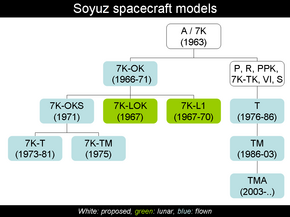
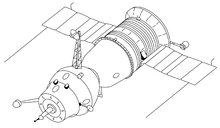
The Soviet Union planned several military Soyuz spacecraft models. These versions were named Soyuz P, Soyuz PPK, Soyuz R, Soyuz 7K-VI, and Soyuz OIS (Orbital Research Station). However, none of the spacecraft ever flew in space. [1] [2]


The Soviet Union planned several military Soyuz spacecraft models. These versions were named Soyuz P, Soyuz PPK, Soyuz R, Soyuz 7K-VI, and Soyuz OIS (Orbital Research Station). However, none of the spacecraft ever flew in space. [1] [2]
The Soyuz P (Perekhvatchik, Interceptor) space interceptor and Soyuz R (Razvedki, intelligence) command-reconnaissance spacecraft was proposed in December 1962 by Sergei Korolev. In the initial draft project, the Soyuz P would use the Soyuz 9K rocket stage and Soyuz 11K tanker spacecraft to conduct a series of dockings and re-fueling operations. The complete complex would then conduct intercepts of enemy satellites in orbits up to 6,000 km in altitude. Soyuz P was cancelled in 1963. [3]
The Soyuz-R system (1963-1966) consisted of two separately launched spacecraft, including the small orbital station 11F71 with photo-reconnaissance and electronic intelligence equipment and a Soyuz 7K-TK for crew transport. Soyuz R was cancelled in 1966. [4]
Initially the Soyuz P was designed for piloted inspection and destruction of enemy satellites. It was intended that the Soyuz would rendezvous with the target satellite. To minimize risk to the crew, a new version, Soyuz PPK (pilotiruemovo korablya-perekhvatchika, crewed interceptor spacecraft) was later proposed in 1964. [5]
The Zvezda (star) station was based on a radically modified Soyuz begun in October 1965. Dmitri Kozlov was the chief engineer of the Soyuz VI project, he also worked on Soyuz-P and Soyuz-R. Soyuz 7K-VI objectives were crew earth observation, orbital inspection and destruction of enemy satellites. Zvezda would be powered by two plutonium radioisotope thermoelectric generators, as solar arrays required the spacecraft to be position to the sun, not a desired attack mode. Also the military experiments need more power than solar provided. Soyuz 7K-VI had a recoilless gun for defense. It was designed for shooting in a vacuum and defending the military research spacecraft from enemy satellite inspector and interceptor satellites. The gun was aimed by maneuvering the entire spacecraft. A special gunsight was installed in the descent module for aiming the gun. A forward docking apparatus to allow docking with Almaz was also included. Work on Zvezda was cancelled in 1967 with a single prototype in advanced stages of construction. Cosmonaut training for the VI began in September 1966. The cosmonaut group selected included commander Pavel Popovich, pilot Alexei Gubarev, flight-engineers Yuri Artyukhin, Vladimir Gulyaev, Boris Nikolaevich Belousov, and Gennadiy Kolesnikov. Popovich-Kolesnikov and Gubarev-Belousov were the prime crews, with the other engineers acting as reserves and then assigned to later crews. [6] [7]
The Soyuz OIS (Orbital Research Station) would consist of a separately-launched orbital block 11F731 OB-VI and a transport Soyuz 7K-S.
The Soyuz OB-VI would be launched for 30-day missions in a 51.6° orbit at 250 x 270 km. Power was provided by solar panels, and the payload included 700 to 1,000 kg of instrumentation. The total mass would be around 6,500 kg (14,300 lb). [8]
The initial Soyuz 7K-S program was to consist of four uncrewed, followed by two crewed test flights, then two operational launches. Cosmonauts were assigned to the project in 1973. [6]
In 1975, the project was cancelled. At that time the launch escape system for 7K-S was ready and was used for Apollo-Soyuz Test Project flights. Three complete vehicles were launched as uncrewed test missions:
The Soyuz 7K-ST transport project was develop in parallel to the military 7K-S and was redesigned for a crew of three, eventually becoming the Soyuz-T used with the Salyut space stations. [9]
The list below shows proposed, flown (in bold) and military (in italic) Soyuz versions.

The Soyuz programme is a human spaceflight programme initiated by the Soviet Union in the early 1960s. The Soyuz spacecraft was originally part of a Moon landing project intended to put a Soviet cosmonaut on the Moon. It was the third Soviet human spaceflight programme after the Vostok (1961–1963) and Voskhod (1964–1965) programmes.

The Salyut programme was the first space station programme, undertaken by the Soviet Union. It involved a series of four crewed scientific research space stations and two crewed military reconnaissance space stations over a period of 15 years, from 1971 to 1986. Two other Salyut launches failed. In one respect, Salyut had the task of carrying out long-term research into the problems of living in space and a variety of astronomical, biological and Earth-resources experiments, and on the other hand the USSR used this civilian programme as a cover for the highly secretive military Almaz stations, which flew under the Salyut designation. Salyut 1, the first station in the programme, became the world's first crewed space station.

Soyuz is a series of spacecraft which has been in service since the 1960s, having made more than 140 flights. It was designed for the Soviet space program by the Korolev Design Bureau. The Soyuz succeeded the Voskhod spacecraft and was originally built as part of the Soviet crewed lunar programs. It is launched on a Soyuz rocket from the Baikonur Cosmodrome in Kazakhstan. Between the 2011 retirement of the Space Shuttle and the 2020 demo flight of SpaceX Crew Dragon, the Soyuz served as the only means to ferry crew to or from the International Space Station, for which it remains heavily used. Although China did launch crewed Shenzhou flights during this time, none of them docked with the ISS.

The Progress is a Russian expendable cargo spacecraft. Its purpose is to deliver the supplies needed to sustain a human presence in orbit. While it does not carry a crew, it can be boarded by astronauts when docked to a space station, hence it is classified as crewed by its manufacturer. Progress is derived from the crewed Soyuz spacecraft and launches on the same launch vehicle, a Soyuz rocket.
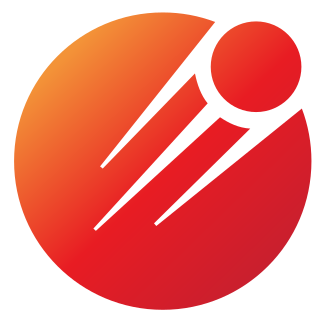
PAO S. P. Korolev Rocket and Space Corporation Energia, also known as RSC Energia, is a Russian manufacturer of spacecraft and space station components. The company is the prime developer and contractor of the Russian crewed spaceflight program; it also owns a majority of Sea Launch. Its name is derived from Sergei Korolev, the first chief of its design bureau, and the Russian word for energy.

Salyut 7 was a space station in low Earth orbit from April 1982 to February 1991. It was first crewed in May 1982 with two crew via Soyuz T-5, and last visited in June 1986, by Soyuz T-15. Various crew and modules were used over its lifetime, including 12 crewed and 15 uncrewed launches in total. Supporting spacecraft included the Soyuz T, Progress, and TKS spacecraft.

Fyodor Nikolayevich Yurchikhin is a Russian cosmonaut of Greek descent, engineer and RSC Energia test-pilot who has flown on five spaceflights. His first spaceflight was a 10-day Space Shuttle mission STS-112. His second was a long-duration stay aboard the International Space Station (ISS) as a flight engineer for Expedition 15; for this mission he was launched in the Soyuz TMA-10 spacecraft. He has undertaken two further long-duration stays aboard the ISS, as a crew member of Expedition 24 / 25. For this mission he was launched with the spacecraft Soyuz TMA-19, and he landed in November 2010, also with the Soyuz TMA-19 spacecraft. He served as Soyuz commander for his fourth mission aboard Soyuz TMA-09M, as flight engineer for Expedition 36 and ISS commander for Expedition 37. In April 2017, Yurchikhin launched on Soyuz MS-04 for the fifth spaceflight of his career, a six-month mission to the ISS as part of Expedition 51 and 52, for which he was the commander.

Zvezda, Salyut DOS-8, also known as the Zvezda Service Module, is a module of the International Space Station (ISS). It was the third module launched to the station, and provided all of the station's life support systems, some of which are supplemented in the US Orbital Segment (USOS), as well as living quarters for two crew members. It is the structural and functional center of the Russian Orbital Segment (ROS), which is the Russian part of the ISS. Crew assemble here to deal with emergencies on the station.
The Soviet-crewed lunar programs were a series of programs pursued by the Soviet Union to land humans on the Moon, in competition with the United States Apollo program. The Soviet government publicly denied participating in such a competition, but secretly pursued two programs in the 1960s: crewed lunar flyby missions using Soyuz 7K-L1 (Zond) spacecraft launched with the Proton-K rocket, and a crewed lunar landing using Soyuz 7K-LOK and LK spacecraft launched with the N1 rocket. Following the dual American successes of the first crewed lunar orbit on 24–25 December 1968 and the first Moon landing on July 20, 1969, and a series of catastrophic N1 failures, both Soviet programs were eventually brought to an end. The Proton-based Zond program was canceled in 1970, and the N1-L3 program was de facto terminated in 1974 and officially canceled in 1976. Details of both Soviet programs were kept secret until 1990 when the government allowed them to be published under the policy of glasnost.

The Soyuz-TM were fourth generation (1986–2002) Soyuz spacecraft used for ferry flights to the Mir and ISS space stations. The Soyuz spacecraft consisted of three parts, the Orbital Module, the Descent Module and the Service Module.
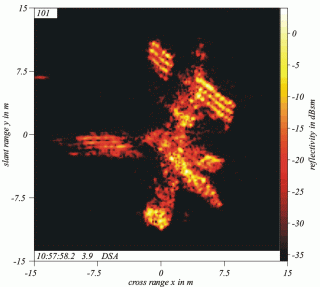
Kosmos 1686, also known as TKS-4, was a heavily modified TKS spacecraft which docked unmanned to the Soviet space station Salyut 7 as part of tests to attach scientific expansion modules to stations in Earth orbit. The module which docked to the station was the FGB component of a TKS vehicle launched on September 27, 1985, and was designed to test systems planned for use on the Mir Core Module. The spacecraft docked with Salyut 7 on October 2, 1985, during the long-duration stay of the cosmonauts of its fifth principal expedition, which arrived on Soyuz T-14. It was the last flown TKS spacecraft.

Sergei Korolev initially promoted the Soyuz A-B-V circumlunar complex (7K-9K-11K) concept in which a two-man craft Soyuz 7K would rendezvous with other components in Earth orbit to assemble a lunar excursion vehicle, the components being delivered by the proven R-7 rocket.

Soyuz 7K-OK was the first generation of Soyuz spacecraft and was flown between 1967 and 1971. The 7K-OK was used for the first ferry flights to the Salyut space station program, beginning a long history of space station service that continues today with the International Space Station (ISS).
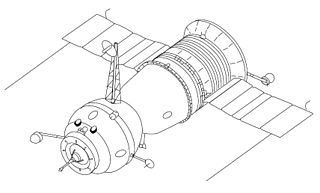
Soyuz 7K-OKS is a version of the Soyuz spacecraft and was the first spacecraft designed for space station flights. Its only crewed flights were conducted in 1971, with Soyuz 10 and Soyuz 11.
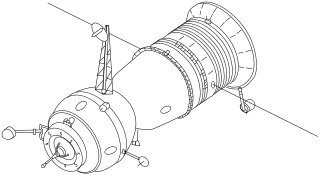
The second generation of the Soyuz spacecraft, the Soyuz 7K-T, comprised Soyuz 12 through Soyuz 40 (1973–1981). In the wake of the Soyuz 11 tragedy, the spacecraft was redesigned to accommodate two cosmonauts who would wear pressure suits at all times during launch, docking, undocking, and reentry. The place of the third cosmonaut was taken by extra life-support systems. Finally, the 7K-T, being intended purely as a space station ferry, had no solar panels, instead sporting two large whip antennas in their place. As a result, it relied on batteries which only provided enough power for two days of standalone flight. The idea was that the Soyuz would recharge while docked with a Salyut space station, but in the event of a docking or other mission failure, the crew was forced to power off everything except communications and life support systems until they could reenter.

The Soyuz TMA-16 was a crewed flight to and from the International Space Station (ISS). It transported two members of the Expedition 21 crew and a Canadian entrepreneur from the Baikonur Cosmodrome in Kazakhstan to the ISS. TMA-16 was the 103rd flight of a Soyuz spacecraft, the first flight launching in 1967. The launch of Soyuz TMA-16 marked the first time since 1969 that three Soyuz craft were in orbit simultaneously.

Soyuz 7K-L1E was a Soviet uncrewed modified Soyuz 7K-L1 spacecraft. Also called a dummy Soyuz 7K-LOK. Two were built, one Soyuz 7K-L1E was successfully launched into Low Earth Orbit on Proton rocket and is known as Kosmos 382. The other Soyuz 7K-L1E was placed on a N1 rocket, which failed at launch. The Soyuz spacecraft was first used in 1967 as the main crewed spacecraft and is still in use. Many Soyuz variations have been built and the Soyuz 7K-L1E was an uncrewed variation.
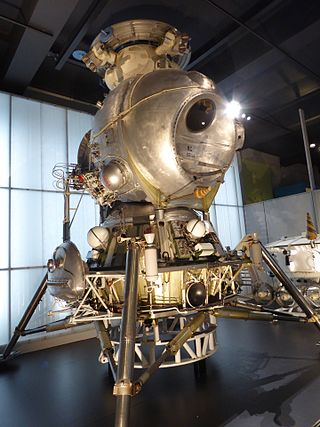
Soyuz Kontakt(Soyuz Contact) was the docking hardware of the Soviet crewed lunar spacecraft program. The Soviet lunar human program was canceled in 1974 after many failures. Four failures of the N-1 Rocket super heavy-lift launch vehicle and the success of the U.S. Apollo program ended the Soviet crewed moon program.
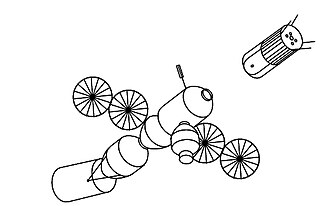
Soyuz Sever, also spelled Soyuz Siber,, was an early (1959–1962) design of the Soyuz spacecraft. The Soyuz Sever design of a crewed spacecraft started the Soyuz programme. In 1956, the Soyuz Sever spacecraft was proposed as the replacement for the Vostok spacecraft. Vostok spacecraft had only a crew of one; the Soyuz Sever plan would have crew of three. Sever was planned to be launched on a R7 rocket or Vostok rocket. The Sever plans were made by the Experimental Design Bureau (OKB-1) of the Soviet Union. While the Sever spacecraft was never built and launched, many of the designs and testing outcomes became part of the first generation Soyuz spacecraft, Soyuz 7K-OK and the Soyuz 1 mission launched on 23 April 1967. Sever final plan was to take crews to a Sever space station, OS-1962.

Aelita was a Soviet design of a version of a Soyuz spacecraft started in 1978. The Aelita was part of the Soyuz programme, but was planned to use an unmanned Soyuz spacecraft as an infrared astronomy telescope satellite. A Soyuz spacecraft was planned to be modified to become the Aelita project satellite. The Aelita project not completed, and was cancelled in 1982.
This section's use of external links may not follow Wikipedia's policies or guidelines.(April 2023) |